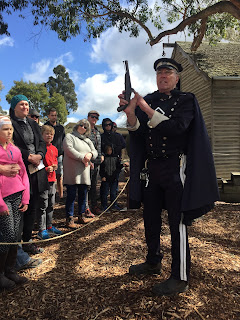 |
| This is a major road; the pavement is not wide enough for two vehicles. |
Our first tourist stop was to take some pictures of a canola field. Canola production seems to be overtaking the farm industry as the demand for canola oil increases as we look ever harder for food that are good for us and oils that can be used to create energy for our industrial needs. Not everyone things this massive canola production is good for us, but they do make for striking scenes as the flowers are a beautiful yellow. I’ve been thinking about the need to a picture to show this, but wanted a scene that had some artistic value since we first saw these fields in England. Wagga had some potential, but I neglected to ask David to stop for a photo op. You can be the judge of my success with the pictures here.
Our second stop was in the small town of Coonalpyn in South Australia, about 90 minutes east of Adelaide. Coonalpyn is one of the many farm towns hurt badly by drought and recession. Instead of wallowing in self-pity, this town worked some grants and involved the local community and schools to create several art projects focusing on the town’s past and the future for its children. The most striking result is the Silo Mural. Students from the local primary school have been painted on the silos by Australian artist Guido van Helten. Because the silo is immediately next to the road, the silo is impossible to miss. In the 30 minutes we spent looking and taking pictures we saw at least a dozen other cars stop and noticed several others enjoying an afternoon tea at the restaurant across the street.
Another major project is the Tunnel Re-vision. The tunnel under the railroad tracks has been decorated with art by local artists and school children. About forty paintings now decorate the tunnel based on the theme of past and future. Also visible are the mosaic of a Wedge-tailed Eagle on the chain-link fence surrounding the tennis court fence fronting the highway. The public toilet has been decorated with another mosaic. We were properly impressed and excited by this community’s efforts to meet their problems with something creative and beautiful that focuses on the future.


















































